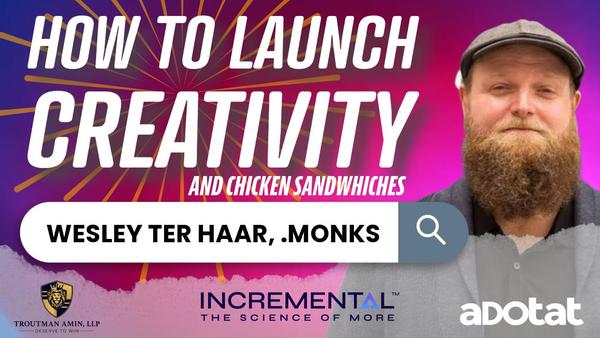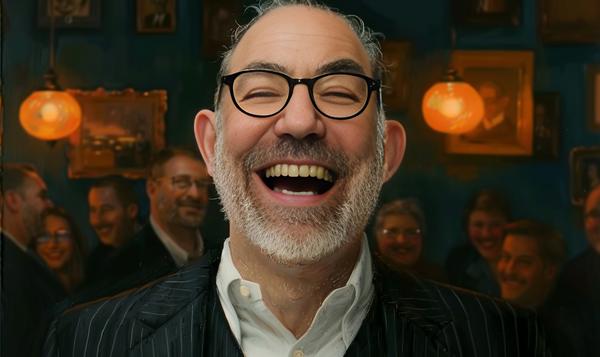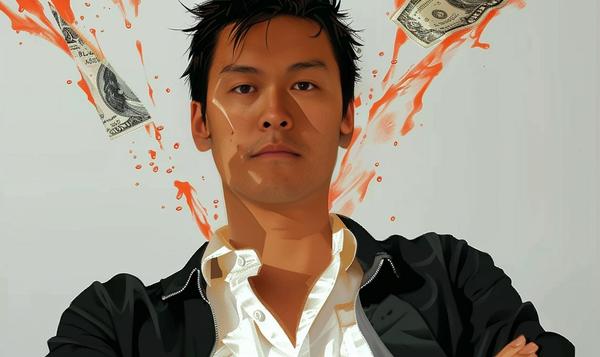AI, Ethics, and a Chicken Sandwich in Space: Wesley Ter Haar’s Bold Moves
Wesley Ter Haar might not be a household name, but in the worlds of advertising, creativity, and digital innovation, he’s a bona fide rockstar. Founder of
Monks—formerly Media Monks—he’s the kind of guy who has seamlessly juggled global teams, weathered industry revolutions, and still managed to sneak in salsa lessons. A conversation with Wesley is like stepping into a whirlwind of ideas, from his nostalgic love for Flash to the ethical dilemmas of AI, and even the finer points of creative freedom on a hypothetical desert island.
Flash, Chicken Sandwiches, and the Early Days
Let’s rewind the clock to a time when Flash wasn’t just a tool—it was the internet’s crown jewel, the ultimate enabler of creative chaos. Back then, Wesley Ter Haar was already making waves, elbow-deep in the untamed wilds of digital innovation. “Everything was very new,” he reflects, his tone equal parts
nostalgia and reverence. “There was a small community of people who were scrappy, trying to figure out what an embodied interactive interface for the web was. You had to think of new things and then figure out if the technology was ready to implement them.”
Flash wasn’t just a medium;
it was an attitude, and Wesley embraced it with all the fervor of a pioneer charting unknown territory. The limitations of the tech were less obstacles and more creative prompts. If the code broke, you fixed it. If an idea seemed impossible, you hacked together a way to make it work. That scrappy, figure-it-out mentality didn’t just shape Wesley’s early career—it became the bedrock of Monks’ DNA.
This relentless drive to experiment, innovate, and adapt turned Monks into a creative force, but it wasn’t without its growing pains. Over the years, the company underwent several pivots, each more challenging than the last. Wesley calls their 2007-2008 transformation—from a digital marketing outfit to a production powerhouse—one of the toughest. “We had to fire all of our
clients,” he says with a wry chuckle. “It was definitely more gut feeling than strategy.” Gut feeling, maybe, but it was the kind of bold, no-turning-back decision that separated Monks from the ack and set them on a trajectory of global impact.
Then came 2013, and with it, what Wesley
fondly refers to as the “space phase.” Apparently, everyone wanted to send something—anything—into space. It wasn’t enough to craft an ad campaign that would go viral on Earth; brands wanted to aim for the stars, literally. “It was really weird,” Wesley recalls, his grin widening at the memory. “We had four pitches at the same time, all about what we could send to space.”
Among the oddball ideas, one stood out: KFC’s infamous chicken sandwich launch in collaboration with Wieden+Kennedy. “We ended up sending a chicken sandwich to space,” Wesley says, still amused by the absurdity of it all. “It stayed up there for six or seven days before coming back down. It’s still one of my favorite random pieces of work.”
But the story isn’t just about novelty; it’s a testament to Monks’ ability to turn even the most outlandish ideas into reality. It was a moment that captured the essence of their ethos: audacious creativity paired with flawless execution. “We always joke, ‘Clearly, we’re in an extremely important industry,’” Wesley adds, tongue firmly in
cheek.
Global Perspective, Local Pride
For a company like Monks, creativity doesn’t happen in a vacuum. It’s a living, breathing ecosystem fueled by the experiences, perspectives, and energy of its people. And when your people are spread across cultural
powerhouses like Amsterdam, LA, and Mexico City, the result is a kaleidoscope of ideas that challenge conventions and push boundaries.
Wesley Ter Haar is quick to highlight the transformative impact of this global exposure. “One of the most exciting things about Monks is how diverse and
global the teams tend to be across the work,” he says, his enthusiasm palpable. “You build an international network of colleagues and, sometimes, friends.” For Wesley, this diversity isn’t just a box to check; it’s the secret sauce that keeps Monks ahead of the curve.
The ability to
pull insights from such varied cultural backdrops means Monks doesn’t just operate globally—it thrives globally. It’s a dynamic environment where the grit of Amsterdam’s tech scene, the Hollywood polish of LA, and the vibrant entrepreneurial energy of Mexico City collide in the best possible way. This cultural mashup infuses their work with a richness and depth that’s impossible to replicate in a single location.
When pressed to name a favorite city, Wesley doesn’t miss a beat: “CDMX, Mexico City,” he says without hesitation. “I think that’s the most exciting place on the planet right now.”
For Wesley, Mexico City is more than just a workplace—it’s a microcosm of creative potential. “The city knows it’s having its moment,” he explains. “There’s this pride, energy, and entrepreneurial vibe because of it. It feels like Berlin in the early 2000s, where everything is happening there. It pulls in interesting people from all over the world.”
This kind of environment isn’t just inspiring; it’s contagious. Mexico City’s energy, its sense of possibility, and its cultural vibrancy have seeped into the very fabric of Monks’ work. Wesley talks about the city like a creative muse—a place where innovation feels inevitable, where the spark of an idea can turn into a full-fledged movement.
And that global perspective? It’s not just about geography—it’s about people. Monks’ teams are a patchwork of cultures experiences, and expertise, working together to create something greater than the sum of their parts. It’s an approach that has not only shaped the company’s identity but also set a benchmark for what global collaboration should look like in the creative industry.
From Underdog to Industry Giant
Let’s not pretend Monks was some grand master plan, meticulously mapped out on a whiteboard in a sleek office. No, Monks’ rise from scrappy digital upstart to global creative juggernaut was more like a chaotic game of pinball—some brilliant shots, a lot of fast pivots, and a few lucky bounces
along the way. Wesley Ter Haar, ever the pragmatist, sums it up with advice he once received: “Somebody told me, ‘Always play like you’re behind.’”
And play behind they did—though from the outside looking in, it didn’t take long for Monks to leap ahead. But for Wesley, the real “aha
moment” came when the industry bubble popped and the outside world took notice. “The first time you start seeing your own work in places outside of the industry echo chamber—when family and friends recognize it—that’s when you realize, ‘Okay, we’re on the inside now,’” he says.
It’s not
every day your mom, your cousin, and your neighbor are talking about the same campaign, but for Wesley, those moments of mainstream recognition weren’t just exciting—they were a turning point. Suddenly, Monks wasn’t just impressing industry insiders; they were making work that resonated far beyond the ad world.
Wesley is quick to wax nostalgic about the early days of virality. “This was back
when you could own the virality of a channel for a few days or a week,” he says, eyes lighting up. Let that sink in: days or even a week. Compare that to today’s hyper-compressed news cycle, where a trending hashtag or viral video might last all of 15 minutes before being buried under the next big thing.
“Now, you’re lucky to win for an hour or even a minute,” he says, laughing. “But back then, seeing people post our work on Facebook and realizing, ‘Oh my God, we made that,’ was one of the most exciting moments.”
It was a simpler time when algorithms weren’t the
gatekeepers they are today, and creative work could snowball organically. “There’s something thrilling about knowing your work dominated the conversation for days,” Wesley reflects. “It wasn’t just a flash in the pan—it was a sustained cultural moment.”
That kind of resonance is what
Monks has always chased, even as the playing field has shifted. The scrappy underdog mindset may have been born out of necessity, but it became a cornerstone of their identity. Wesley admits that even now, with Monks firmly established as a global creative powerhouse, they still operate like the scrappy upstart with something to prove.
“We try to play like we’re behind,” he says, a subtle grin betraying just how far ahead they actually are. But maybe that’s the secret to their success: never letting the world know just how good they’ve become. Keep them guessing, keep them inspired, and most importantly, keep them wanting more. Monks isn’t just a name anymore—it’s a force.
AI: The Creative Superpower or the Next Dystopia?
As Monks pivots yet again, this time into the AI-driven era, Wesley admits the challenge is both exhilarating and daunting. The company was recently named Adweek’s first-ever AI Agency of the Year, a milestone Wesley describes as validation for their work in navigating this technological
revolution.
“AI is clearly at least as big as the shifts we’ve seen with mobile, social, or programmatic,” he says. “But I suspect it’s quite a bit bigger.” Monks has already integrated AI into creative workflows, using it as a co-pitching partner or even a competitive brainstorming
tool. “Some creatives have the machine pitch the 10 most stereotypical results for a brief so they know what to avoid,” he explains.
But it’s not all sunshine and supercomputers. Wesley is acutely aware of AI’s ethical pitfalls, from bias in targeting to the risk of creating synthetic
humans. “We’ve set clear guidelines,” he says. “There are things we don’t do, like using AI for dark pattern UIs or exploiting people’s weaknesses through hyper-targeted ads. Those are the real Black Mirror scenarios.”
The Moral Minefield of Advertising
Navigating the ethical complexities of AI is one thing; balancing creativity with corporate demands is another. Wesley describes leadership at Monks as “a combination of ambition and change,” a culture that thrives on evolution rather than resisting it. “We’re honest and transparent about what change means for us as a business,” he says. “That emboldens people to be part of figuring stuff out instead of waiting for some decree from the top.”
And yet, even he admits there’s no clear roadmap for the future. “The lack of clarity is what excites me most,” he says. “Nobody can confidently describe what five years from now will look like. If that doesn’t excite you, you probably shouldn’t be in this business.”
The Man Behind the Monks
For a guy who’s built a global creative empire and sent chicken sandwiches into orbit, Wesley Ter Haar is surprisingly chill. You’d expect someone at the helm of Monks to have a calendar that looks like a NASA mission schedule, but Wesley? He’s got his priorities in order. Case in point: his guilty
pleasure. “Sleeping in until noon on Sundays,” he confesses, completely unbothered by the chaos of the world. “People probably think I don’t sleep, but if I can get away with it, I’m just hanging out in bed.”
Yes, the man who can command a room full of ad execs or steer a creative pivot
like a Formula 1 driver is also perfectly content to snooze through brunch. And honestly? Respect. After all, who’s going to argue with a guy who’s mastered the art of balance—work hard, nap harder.
But don’t let the Sunday sleep-ins fool you into thinking he’s a slouch. Wesley’s also a
salsa dancer, and not just the kind who awkwardly shuffles around at weddings. “We brought our very Western European way of dancing to Mexico City, and it wasn’t going to fly,” he says, clearly amused at his past missteps. The solution? Dive headfirst into two years of lessons to learn how to actually move. “Now, I think we can at least hold our own,” he adds with a grin.
Picture this: Wesley, the tech-savvy maestro of Monks, spinning on the dance floor with all the flair of a creative brief gone right. It’s the kind of unexpected detail that makes you wonder what else he’s hiding—juggling? Competitive knitting? Who knows. But one thing’s for sure: Wesley isn’t just a boss in the boardroom; he’s got rhythm to match.
Legacy, Leadership, and Looking Ahead
What does Wesley want his legacy to be? “Honestly, I think it’s the beard,” he jokes. But on a more serious note, he hopes Monks will continue to push boundaries, not just in advertising but across industries. “We’re already doing some amazing work in broadcast, using
generative AI in ways that completely reimagine live production. There’s so much opportunity to broaden our offering and bring our DNA of innovation to new challenges.”
And if he had unlimited resources? “I’d build more software,” he says. “There’s so much potential to productize this
new AI-driven infrastructure. We’re doing a lot of it for clients now, but I’d love to do more for ourselves.”
Wesley Ter Haar isn’t just riding the waves of change; he’s building the surfboard. From Flash to AI, chicken sandwiches to salsa, his journey is a masterclass in creative
evolution. If Monks is the empire, Wesley is its architect—a scrappy, ambitious dreamer with a knack for turning the impossible into the unforgettable.









